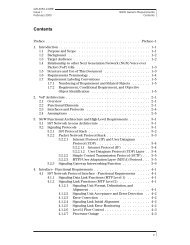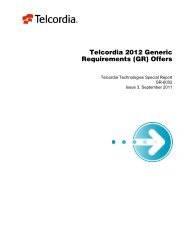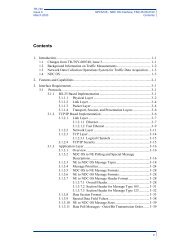(NGN) Documents - Telcordia Information SuperStore - Telcordia ...
(NGN) Documents - Telcordia Information SuperStore - Telcordia ...
(NGN) Documents - Telcordia Information SuperStore - Telcordia ...
Create successful ePaper yourself
Turn your PDF publications into a flip-book with our unique Google optimized e-Paper software.
ROADMAP-TO-<strong>NGN</strong>-1<br />
Roadmap to <strong>NGN</strong> <strong>Documents</strong> Issue 2, August 2008<br />
Your Roadmap to <strong>NGN</strong> <strong>Documents</strong><br />
3–10<br />
6.2 File Transfer Protocol<br />
6.3 Telnet<br />
6.4 Middle Layer Protocols<br />
6.5 Lower Layer Protocols<br />
6.6 Data Compression<br />
7. BA/Element Management System Interface Generic Requirements<br />
Appendix A: Call Connection Scenarios and Recording Responsibility<br />
A.1 RADIUS<br />
A.2 Diameter<br />
A.3 Mapping Diameter/RADIUS Fields to Usage Elements in PDU<br />
Appendix B: Formatting PDUs<br />
B.1 On-Net Call Origination<br />
B.2 Disconnect PDU<br />
GR-3059-CORE, Generic Requirements for Voice Over Packet End-to-End<br />
Performance<br />
This document sets forth generic end-to-end performance requirements for packet<br />
based networks providing voice service using Next Generation Networks (<strong>NGN</strong>)<br />
architecture. These requirements consist of performance parameters definitions,<br />
objectives, and allocation rules. The end-to-end objectives may be specialized to<br />
specific networks through the use of the allocation rules. To complement these<br />
allocation rules, objectives are also given for selected network elements in the <strong>NGN</strong><br />
architecture. Both the case of pure IP and ATM networks are considered, along with<br />
the case of a hybrid IP and ATM network. These requirements provide a basis for<br />
interworking between networks, and give guidance to equipment manufacturers.<br />
They offer consistency with the minimal performance floors of standards, and can<br />
be used in network design and capacity planning.<br />
Contents<br />
1. Introduction<br />
2. VoP Performance Models<br />
2.1 Measurement Points<br />
2.2 Performance Significant Reference Events<br />
2.3 Signaling Reference Models<br />
2.4 Transport Reference Models<br />
3. Signaling Performance<br />
3.1 Delay Concepts<br />
3.2 Classification of Call Attempts and Call Releases<br />
3.3 Access Function Performance Parameter Definitions<br />
3.4 Access Function Objectives<br />
3.5 Access Function Allocation Rules





